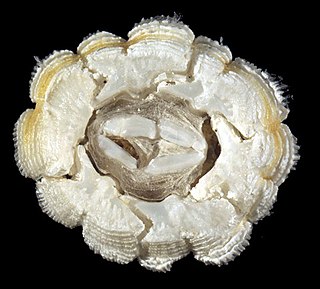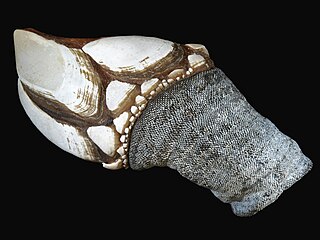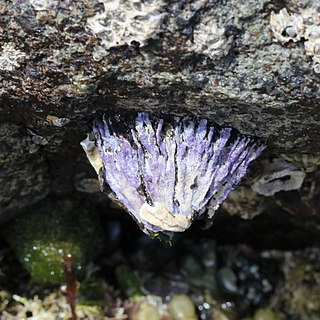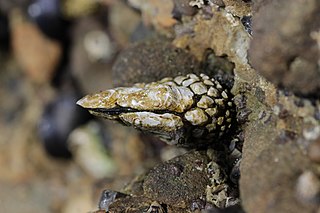
Thoracica is an infraclass of crustaceans which contains the most familiar species of barnacles found on rocky coasts, such as Semibalanus balanoides and Chthamalus stellatus. They have six well-developed limbs, and may be either stalked or sessile. The carapace is heavily calcified. The group includes free-living and commensal species.

Thecostraca is a class of marine invertebrates containing over 2,200 described species. Many species have planktonic larvae which become sessile or parasitic as adults.

The Balanidae comprise a family of barnacles of the order Balanomorpha. As a result of research published in 2021 by Chan et al., the members of the family Archaeobalanidae were merged with this family.
In the past, Lernaeodiscidae has been considered a family of barnacles. Research published in 2021 by Chan et al. resulted in the genera of Lernaeodiscidae being merged with that of Peltogastridae, which now contains the members of both families. As an exception, the species Triangulus galatheae was moved to the genus Paratriangulus in the family Triangulidae.

Platylepas is a genus of barnacles in the family Platylepadidae of the subphylum Crustacea.

Scalpellomorpha is an order of acorn barnacles in the class Thecostraca. There are about 11 families in 3 superfamilies and more than 450 described species in Scalpellomorpha.
Eolepadidae is an extinct family of barnacles in the order Eolepadomorpha. There are 2 genera and about 12 described species in Eolepadidae.

Dosima is a genus of goose barnacles in the family Lepadidae. There are at least two described species in Dosima.

Austrobalanus is a genus of symmetrical sessile barnacles in the family Austrobalanidae, the sole genus of the family. There are at least three described species in Austrobalanus.
Lithoglyptida is an order of barnacles in the class Thecostraca. There are 2 families and more than 40 described species in Lithoglyptida.

Brachylepadidae is an extinct family of barnacles in the order Brachylepadomorpha, the sole family in the order. There are about 7 genera and more than 20 described species in Brachylepadidae.
Iblomorpha is a small order of barnacles in the class Thecostraca. There are only two families and about eight described species in Iblomorpha. In this group we find barnacles that use calcium phosphate in their shell, and species that protect themselves against predators with poison.

Calanticomorpha is an order of acorn barnacles in the class Thecostraca. There are 3 families and more than 90 described species in Calanticomorpha.

Pollicipedomorpha is an order of pedunculated barnacles in the class Thecostraca. There are 3 families and more than 30 described species in Pollicipedomorpha.

Verrucomorpha is an order of asymmetrical sessile barnacles in the class Thecostraca. They are typically found in deeper and deep-sea habitats. There are 2 families and more than 100 described species in Verrucomorpha.
Probathylepas is a genus of acorn barnacles in the family Probathylepadidae, the sole genus of the family. There is one described species in Probathylepas, P. faxian.
Pirusaccus is a genus of parasitic barnacles in the family Pirusaccidae, the sole genus of the family. There is one described species in Pirusaccus, P. socialis.

Triangulus is a genus of parasitic barnacles in the family Triangulidae, the sole genus of the family. There are at least four described species in Triangulus.

Waikalasma is a genus of symmetrical sessile barnacles in the family Waikalasmatidae, the sole genus of the family. There are at least three described species in Waikalasma.












